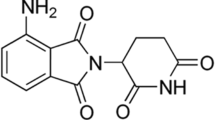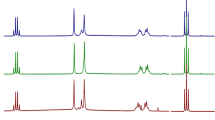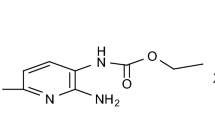Abstract
Seven polymorphic modifications of doxazosin mesylate, designed as forms A, D, E, F, G, H, I, and the amorphous state were studied by thermal methods (TG and DSC), temperature resolved X-ray powder diffractometry, hot stage and scanning electron microscopy and by FT-IR spectroscopy. Amorphous form was obtained either by fast evaporation of the solvent or by fast cooling of the melt in the DSC. Polymorphs A and F were found to be stable in the temperature range from room temperature to their melting points at 277.9 and 276.5°C, respectively. Form G, which melts at 270.8°C, was found to be hygroscopic. Polymorph D undergoes irreversible solid–liquid–solid phase transition at 235.5°C to polymorph I which melts at 274.9°C. Form H, which melts at 258.0°C, was found to be unstable at high temperatures. DSC examinations revealed that form H is irreversibly transformed to polymorph F during heating above the temperature of about 240°C. The amorphous state was found to be stable at room temperature but when heating above the glass transition (T g=144.1°C) it crystallizes at 221.6°C, what leads into a mixture of polymorphic forms. The new polymorphic form designed as E was identified in the mixture. The polymorph E is converted by heating to the more stable form F. The solubilities at 25°C for forms A, and F in methanol are 3.5 and 7.7 mg mL−1and in water they are 3.8 and 6.2 mg mL−1, respectively.
Similar content being viewed by others
References
D. J. W. Grant, Theory and origin of polymorphism, in Polymorphism in Pharmaceutical Solids, H. G. Brittain (ed.), Marcel Dekker 1999, p. 1.
D. Giron, J. Therm. Anal. Cal., 56 (1999) 1285.
T. L. Threlfall, Analyst, 120 (1995) 2435.
H. G. Brittain, J. Pharm. Sci., 86 (1997) 405.
E. Marti and D. Giron, Chimia, 51 (1997) 747.
P. Klein, M. Thyes and D. Hlix, WO 99/35143 (1998).
I. Grafe and J. P. Morsdorf, EP 0 849 264 A1 (1996).
I. Grafe and J. P. Morsdorf, EP 0 849 265 A1 (1996).
I. Grafe and J. P. Morsdorf, EP 0 849 266 A1 (1996).
V. Cannata, S. Piani, C. Carrara and S. Saguati, EP 0 848 001 A1 (1997).
X. Liying, S. Desen and L. Shaosun, Chines. J. Med., 5 (1995) 266.
M. Grčman, A. S. Čurin, B. Šuštar and F. Vrečer, Farm. Vestn., 48 (1997) 292.
Author information
Authors and Affiliations
Rights and permissions
About this article
Cite this article
Grčman, M., Vrečer, F. & Meden, A. Some Physico-chemical Properties of Doxazosin Mesylate Polymorphic Forms and its Amorphous State. Journal of Thermal Analysis and Calorimetry 68, 373–387 (2002). https://doi.org/10.1023/A:1016019214704
Issue Date:
DOI: https://doi.org/10.1023/A:1016019214704




